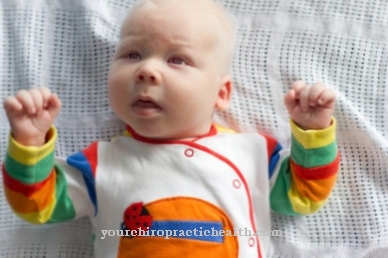The Elbow dislocation or Elbow dislocation is the complete dislocation of the elbow joint. It is usually triggered by trauma and there are also injuries to the collateral ligaments, nerves or broken bones. In children, the elbow dislocation is the most common dislocation, in adults the second most common after dislocation of the shoulder joint.
What is an Elbow Dislocation?
.jpg)
Colloquially, the elbow dislocation is called "dislocated" or "dislocated". Medically, this means that the elbow joint is severely displaced and no longer in its original anatomical position. The joint head is no longer in the joint socket.
In some cases, there are accompanying injuries to the collateral ligaments, bone fractures or, through overstretching, injuries to the forearm nerves ulnar and median nerves.
The elbow dislocation manifests itself symptomatically as a misalignment of the elbow, severe pain and significant elbow movement restrictions. If additional injuries occur, for example a stretching of the forearm nerve on the elbow side, impairment of feeling in the hand can occur.
If the joint head is still partially in the joint socket, one speaks of a subluxation of the elbow.
causes
In rare cases, the elbow dislocation is congenital and occurs from birth. This is an incomplete formation of the elbow or humerus, which unstabilizes the elbow joint. The individual bones now shift slightly against each other.
The habitual dislocation is more common. In this case, the elbow joint dislocates spontaneously repeatedly for no externally apparent reason.
The most common causes, however, are falls or the effects of violence on the hyperextended elbow. The abrupt force causes the joint surfaces to be separated from one another and shifted against one another. The articular surfaces retain this abnormal position even after the end of the force. It is not uncommon for capsular tears in the joint and ligament tears to develop.
Symptoms, ailments & signs
In most cases, an elbow dislocation is associated with other injuries or trauma and does not occur on its own. However, it primarily leads to very severe pain in the affected body region. The pain often spreads to the neighboring regions and leads to complaints there too.
Elbow dislocation can lead to pain and difficulty falling asleep, especially at night. Many sufferers are therefore irritable or slightly aggressive and suffer from various psychological upsets or even depression. There are also restrictions in movement and, in general, a misalignment of the elbow.
If the elbow dislocation is not treated, numbness and disorders of sensitivity occur, which can spread to the arms and hands. In some cases, the patients are therefore dependent on the help of other people in their everyday life and cannot do many everyday things on their own. Elbow dislocation can also cause swelling. In children, the symptoms lead to delayed development. However, it does not have a negative impact on the life expectancy of the patient.
Diagnosis & course
Acute elbow dislocation requires rapid treatment by a competent expert in order to minimize the risk of vascular and nerve damage. The doctor can feel the displaced joints.
The blood circulation and function of forearm muscles and the feeling of the skin on the forearm must also be examined in order to rule out accompanying diseases. The X-ray examination is important in order to be able to differentiate clearly between fractures and an elbow dislocation. Therapy can only be initiated after fractures have been ruled out. A check-up after a few weeks is used to assess the success of the treatment.
Since the elbow dislocation can be easily determined by taking anamnesis and examination, other diagnostic methods such as magnetic resonance imaging and computed tomography are only used to better assess the consequences of injury, such as nerve damage.
In the case of a simple elbow dislocation without accompanying injuries, a very good prognosis can be assumed. After three to four months, the elbow joint is fully resilient.
Complications
The side effects of a lack of bony stabilization and especially a simultaneous fracture of the radial head and a fracture of the Proc. Coronoid there may be a tendency to dislocate. Because capsule and ligament parts are almost always injured in an elbow dislocation, a lateral instability with permanent status can occur regardless of surgical or conservative treatment.
The more severe the dislocation, the higher the risk of a circular crack in relation to the ligament complex. This would appear from lateral to medial. In addition, osteochondral flakes (cartilage bone shedding) can occur. Osteochondrosis dissecans may also develop.
Free osteochondral fragments cannot be excluded either. Elbow osteoarthritis is one of the long-term complications. If vascular nerve lesions are added to the elbow dislocation, there is a risk of gangrene of the hand or forearm. A forearm compartment syndrome cannot be ruled out.
One of the possible complications is a joint stiffening in the narrow range of motion. There may also be a functional limitation.
Periarticular ossifications, which result in considerable restrictions on movement, are very common. In the case of a simple dislocation without accompanying injuries, instability problems are known but rare. More often, however, there is persistent pain and stiffness.
When should you go to the doctor?
If the person concerned finds that their elbow joint can no longer bend and straighten as usual, there is cause for concern. A doctor should be consulted as soon as there is pain or movement is impaired. If cracking noises can be heard during normal movements, a doctor's visit is advisable. As soon as everyday tasks can no longer be carried out as usual or professional obligations can no longer be pursued, a doctor is required.
If there is swelling in the region of the joint, changes in the skin can be seen or bruises form, a doctor must be consulted. Consultation with a doctor is also recommended for emotional and psychological problems. Mood swings, periods of depression or abnormal behavior changes should be clarified by a doctor. If sleep disturbances occur, if there is fatigue or a general malaise, a doctor should be consulted.
Before taking a medication, you should always consult a doctor to discuss possible side effects or risks. If the usual level of performance drops or if the symptoms lead to one-sided physical strain, a doctor should be consulted. If you have muscle pain, tension in your arms, shoulders or back, it is advisable to seek medical care. A sleeping position of the upper body must also be examined.
Doctors & therapists in your area
Treatment & Therapy
Fast treatment is important in any case. Experts recommend it within six hours to minimize the risk of nerve and vascular damage. As an initial measure until a doctor can be reached, we recommend protecting and cooling the joint, because the lower the swelling, the easier it is to straighten it.
The individual treatment of the elbow dislocation is based on the detailed anamnesis, diagnosis and complexity assessment. Since the conservative treatment with re-positioning of the joint is very painful, it is usually carried out under anesthesia. Surgery is not always necessary even if soft tissues are involved.
Surgical therapy is indispensable for open dislocations, vascular and nerve injuries, recurrent dislocations after dislocation and fractures. During this operation, the attending physician sutures injured soft tissue structures and stabilizes the bone injuries with wires or screws. A complete immobilization of the joint with metal wires is performed if the ligament is severely torn.
Depending on the therapy carried out, physiotherapy exercises are carried out shortly after the re-alignment and splinting or only after the surgical wound has healed. The aim of physiotherapy is to strengthen the muscles and restore full joint mobility. A movement orthosis can have a supportive effect.
Outlook & forecast
If there are no other injuries to the bones or surrounding vessels, the prognosis for an elbow dislocation is favorable. The elbow dislocation can heal completely within a few months with sufficient rest and protection.
In a medical treatment, the joint is set back in a few simple steps. After about 3-4 months, the arm and elbow can normally be fully loaded again as usual. Nevertheless, some patients report that they can cope with stress in the further course, which depends on the daily form. Overexertion should therefore be avoided permanently for a good prognosis. Spontaneous healing is not to be expected with a dislocation. Medical care is necessary to achieve relief from the symptoms.
If the cause of the elbow dislocation resulted in bone splintering, surgery is often necessary. The necessary corrections are made in this. Healing is also possible in most cases, but must be assessed on the basis of the individual injuries.
If the complaints lead to a chronic disease of the bones, the prognosis worsens. The symptoms increase in intensity as the disease progresses. The last option is to replace the joint. This allows the patient to use his arm and achieve good functional activity in everyday life.
prevention
It is difficult to prevent elbow dislocation because falls cannot always be avoided. Anyone who suffers from a congenital weakness of the elbow joint or habitual dislocation should, however, take special care of the joint and avoid risk factors.
Aftercare
Elbow dislocation generally does not have a negative impact on the life expectancy of the person affected. In most cases, however, the patient has no special measures and options for follow-up care available, so that the patient is first dependent on a complete healing of the symptoms. Since this cannot lead to self-healing, an early diagnosis with early treatment should always be carried out.
This is the only way to avoid or limit further complications as far as possible. The treatment itself takes place either by straightening the joint or by a surgical procedure. The affected person should not strain his body after the procedure and in any case take it easy. Bed rest is also to be observed, whereby strenuous or stressful activities are to be avoided.
In many cases, the affected joint should be spared and not strained when an elbow is dislocated. The movement of the joint can usually be restored relatively well through measures of physiotherapy or physiotherapy. Many exercises can also be carried out on your own, which may help the elbow dislocation to heal. Support and care from friends and family will also help heal this complaint.
You can do that yourself
An elbow dislocation, also called elbow dislocation, is often the result of violence or falls on the elbow. This injury requires an accurate diagnosis and proper treatment by an expert.
Cooling the elbow joint concerned is recommended as a first aid measure until the doctor arrives. It has to be adjusted as soon as possible, which is often done under anesthesia, otherwise it would be too painful.
Usually the patient has to wear an upper arm cast for seven to ten days after the reduction. The arm needs absolute rest and must be held in a perpendicular crossed position.
If the cast is removed, a movement orthosis can be put on. It stabilizes the joint and at the same time enables a slow approach to normal movements. During this time it is very important to follow the prescribed physiotherapy treatments and actively support them.
The treating physicians and physiotherapists tell the patient how this is best done. It takes some time before the arm and elbow joint can be fully loaded again. Until then, it is important to activate the joint without overwhelming it.
There are no preventive measures that can prevent elbow dislocation or elbow dislocation from the outset. However, you should try to avoid risky situations that can lead to falls with corresponding consequences.





.jpg)

















.jpg)



